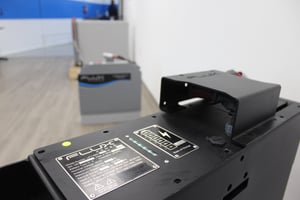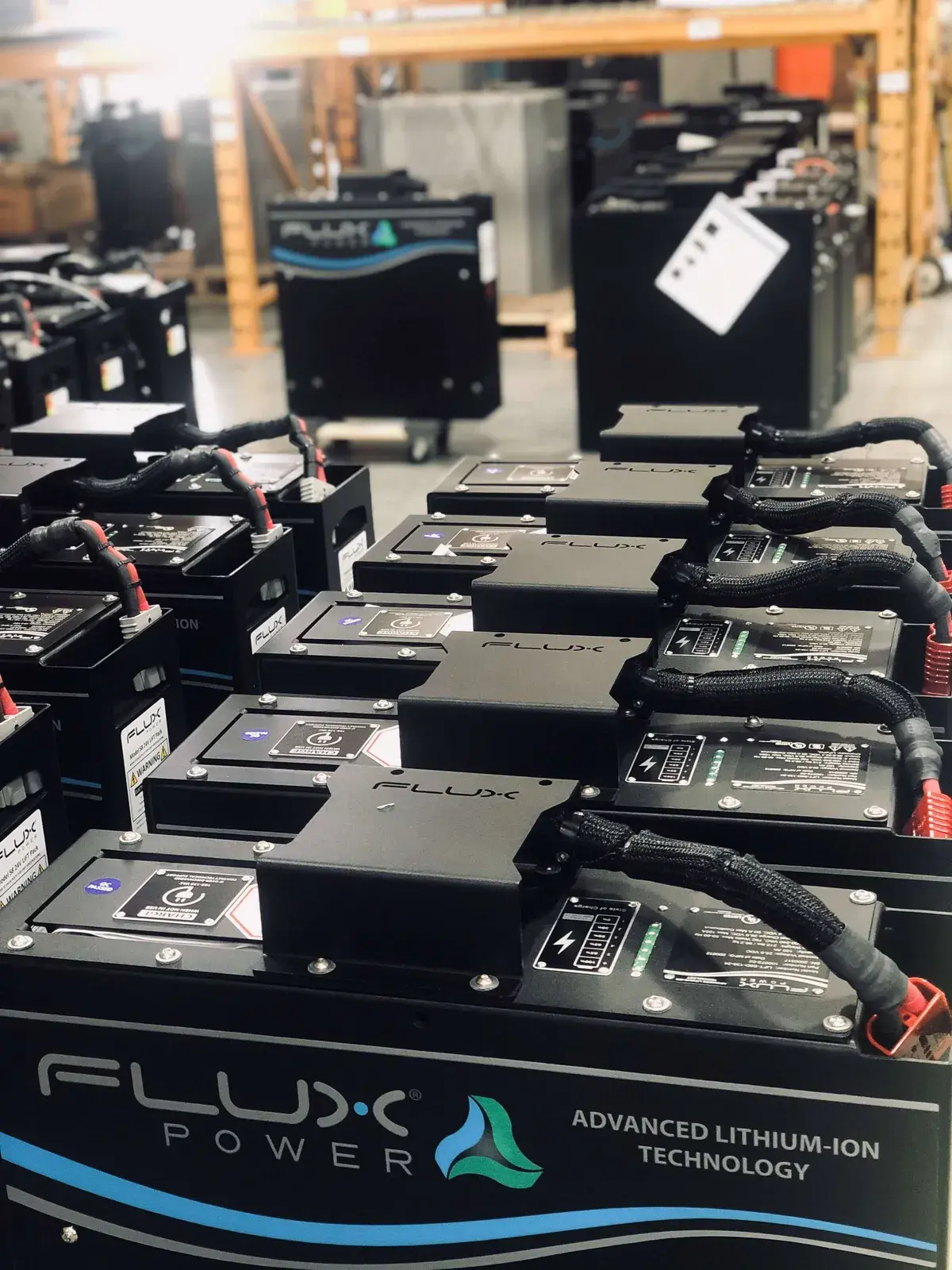Industrial batteries are becoming more popular for use in material handling equipment now and in the future since lithium-ion batteries outperform lead acid batteries.
Lead acid batteries can present unique safety risks to workers due to their heavy weight, specific maintenance requirements, and the potential for toxic gas leaks. It is essential to understand these risks associated with the battery materials, charging procedures, and disposal requirements to keep employees safe and equipment moving.
If you’re looking for a place to start understanding lithium-ion battery safety, here is a how-to guide on what to look for when selecting and evaluating batteries.
Battery Materials
Battery Electrolyte: Risks and Considerations
When considering what to look for in battery safety, the battery type and materials used such as battery electrolytes, is important.
Battery electrolyte is the solution within the battery that acts as a catalyst to conduct electricity. In a lithium-ion battery, the electrolyte typically consists of different organic carbonates that vary based on the manufacturer.
In a lead acid battery, the electrolyte is sulfuric acid, which can be very harmful if spilled or splashed on skin. With regular usage the electrolyte level in a lead acid battery will drop and the electrolytes will need to be replaced frequently. To replace the battery’s electrolytes and maintain performance, water maintenance is needed for a lead acid battery.
Keep in mind that battery watering needs to be periodical to keep the battery functioning. This is a process that presents several safety risks. Workers must be careful to fill the exact amount of water needed for the battery electrolyte and only do it when the battery is fully charged and cooled down. Unlike lead acid batteries, lithium-ion battery electrolytes are permanently sealed inside the battery cell and do not require any maintenance.
Charging Procedures
Battery Charging Hazards
Lithium-ion battery charging is very different than lead acid battery charging. Not every battery can be “opportunity charged” the way  lithium-ion batteries can. Without a weekly equalization charge, opportunity charging for a lead acid battery can reduce its capacity and shorten its lifespan.
lithium-ion batteries can. Without a weekly equalization charge, opportunity charging for a lead acid battery can reduce its capacity and shorten its lifespan.
During the lead acid battery charging process, hydrogen and oxygen gasses are released. Because of this phenomenon known as “gassing”, they must be removed from the equipment and go in a separate charging station that has adequate ventilation and the ability to measure gas levels in the air so that workers can remain safe.
Since lead acid batteries require removal from the vehicle for charging, this presents one of the greatest safety risks – the transferal of a heavy battery. With lithium-ion batteries, that is one less thing to worry about, since the batteries can remain inside the forklift and charge when the equipment is not in use. Keeping the battery inside the equipment makes the charging process both safer and more efficient.
The safest and most effective way to charge a lead acid battery is with multi-stage charging. If the charging process is not carefully broken down into steps, excessive gassing will occur, which can create a very dangerous environment if the battery overheats with highly flammable gases.
What is Thermal Runaway and Why is it Dangerous?
Thermal runaway is a chain reaction of rapidly increasing temperature in an overheated battery, which can be disastrous. Thermal runaway can occur in any type of battery that has been damaged or mishandled and is one of the biggest safety risks associated with industrial batteries.
Thermal runaway in lead acid batteries can be triggered by unregulated charging, poor ventilation, or high operating temperatures.
Lithium-ion batteries experience thermal runaway most commonly due to high operating temperatures or a short circuit. This risk can be reduced with a Battery Management System (BMS) that continuously checks on the thermal and mechanical stability of the battery and shuts down if it’s overheating to prevent thermal runaway.
Risk Prevention
How a Battery Management System (BMS) helps Prevent Risk
Depending on the manufacturer, a battery management system is used to monitor the condition of the battery. This system is the “brain” of a lithium-ion battery and stores operational data about the battery which can be accessed for performance analysis.
The BMS manages the battery’s charge and performs an auto-balancing of the cells near the top of the charge, preventing overcharging and improving the battery’s performance.
In comparison, lead acid batteries do not have a BMS integrated into their design. The lack of an integrated BMS makes it more difficult to monitor the performance of lead acid batteries.
Practice Safe Battery Disposal for Risk Management
There are many federal regulations in place to ensure safety and compliance for battery disposal. Certain metals used in batteries are considered hazardous and need to be recycled to prevent more contamination to the environment.
Since lithium-ion technology is relatively new, lithium-ion battery disposal and its effects on the environment are not as well-documented as lead acid batteries. However, since they generally don’t contain problematic metals like lead, they don’t actively damage the environment when disposed of in landfills.
The lead contained in lead acid batteries creates environmental problems from beginning to end, even in the recycling process. Production of lead acid batteries accounts for around 85% of the world’s lead consumption, and contamination from recycling lead acid batteries has been well-documented around the world.
Because there is a demand for battery material recycling, there has been a growth in recycling plants, where a battery is taken when it reaches end of life. Most businesses selling batteries have recycling and replacement options where they will recycle the battery for you. When searching for the right battery, it is important to ask the battery supplier about their battery recycling practices and options for when the battery reaches end of life.
Look for the Safety Certification: UL Listed vs UL Recognized
Defects in battery design are the cause of a lot of safety hazards, so it’s important to know that the batteries you’re using have been vetted to meet nationally recognized safety standards.
Underwriters Laboratories (UL) is a global safety certification company that performs OSHA-approved safety testing for lithium-ion batteries.
If a battery is UL Listed, that means it has been tested and found to be safe under simulated conditions of potential mishandling or damage.
UL Listed differs from UL Recognized in that UL Listed products are complete products, whereas UL Recognized just means it was tested as a component of a finished product and must be factory installed.
One of the best ways to manage risk for lithium-ion battery safety is to make sure batteries are UL Listed
The Longer the Battery Lifespan, the Smaller the Footprint
It is important to consider a battery’s lifespan in assessing the overall environmental impact.
A battery’s lifespan is measured in charging cycles, which is the number of times they can be drained and recharged before they lost a certain amount of their original capacity. Lithium-ion battery life is generally two times longer than lead acid battery life, powering through 2000-3000 cycles compared to a lead acid battery’s 1000-1500 cycles.
So, an accurate comparison of the environmental impact would match one lithium-ion battery against two (or more) lead acid batteries.
What’s the Best Type of Lithium-Ion Battery?
Not all lithium-ion batteries are created equal, and their internal stability can vary greatly based on their chemistry. Small and wearable lithium battery-powered devices typically use a different kind of lithium-ion battery chemistry than larger industrial equipment.
The different types of lithium-ion chemistries include:
- Lithium Titanate, which is typically used in electric vehicles, car audio applications, and mobile medical devices.
- Lithium Cobalt Oxide, which is mostly used in cell phones, laptops, and smaller powered devices.
- Lithium Nickel Manganese Cobalt Oxide, which is used in electric vehicles, e-bikes, and medical equipment.
- Lithium Iron Phosphate, which is typically used in forklifts and material handling equipment.
For material handling equipment, lithium iron phosphate (LiFePO4) is thermally stable and can handle very high and low temperatures, meaning unlikely to experience thermal runaway. They can be used at temperatures up to 131 degrees Fahrenheit with no risk of combustion or damage to the battery.
It’s crucial for operators to always follow the battery manufacturer’s instructions to minimize risk. In the event of mishandling, lithium iron phosphate batteries are generally the safest compared to other lithium-ion chemistries.
When selecting a forklift battery, it’s important to understand all the different aspects of safety in order to make an informed decision on the best battery for your business.












